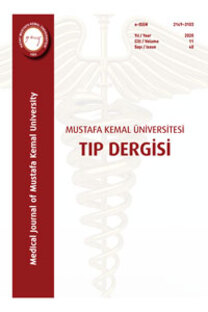COVİD-19 Pnömonisinde Prokalsitonin Düzeylerinin Önemi
COVID-19, Pnömoni, Prokalsitonin
The Importance of Procalcitonin Levels in COVID-19 Pneumonia
COVID-19, Pneumonia, Procalcitonin,
___
- Metintas S. Epidemiology of COVID-19. Eurasian J Pulmonol 2020;22, Suppl S1:2-7.
- T.C. Sağlık Bakanlığı Halk Sağlığı Genel Müdürlüğü: COVID-19 (SARS-CoV-2 Enfeksiyonu) Rehberi. Bilim Kurulu Çalışması, T.C. Sağlık Bakanlığı 12 Nisan 2020, Ankara.
- Nishiura, H.; Linton, N.M.; Akhmetzhanov, A.R. Initial Cluster of Novel Coronavirus (2019-nCoV) Infections in Wuhan, China Is Consistent with Substantial Human-to-Human Transmission. J. Clin. Med. 2020, 9, 488. https://doi.org/10.3390/jcm9020488.
- McIntosh K. Coronavirus disease 2019 (COVID-19): Epidemiology, virology, clinical features, diagnosis, and prevention. UpToDate. (https://www.uptodate.com/contents/coronavirus-disease-2019-covid-19-epidemiology-virology-clinical-features-diagnosis-and-prevention).
- Guan WJ, Ni ZY, Hu Y, Liang WH, Ou CQ, He JX, et al. Clinical characteristics of coronavirus disease 2019 in China. N Engl J Med 2020;NEJMoa2002032. https://doi.org/10.1101/2020.02.06.20020974.
- Wang Z, Yang B, Li Q, Wen L, Zhang R. Clinical Features of 69 Cases with Coronavirus Disease 2019 in Wuhan, China. Clin Infect Dis 2020;ciaa272. https://doi.org/10.1093/cid/ciaa272.
- Wang C, Horby P, Hayden FG, Gao GF. A novel coronavirus outbreak of global health concern. Lancet 2020;395:470-473. https://doi.org/10.1016/S0140-6736(20)30185-9.
- Li Z, Yi Y, Luo X, Xiong N, Liu Y, Li S, et al. Development and clinical application of a rapid IgM-IgG combined antibody test for SARS-CoV-2 infection diagnosis. J Med Virol. 2020. 27:25727. https://doi.org/10.1002/jmv.25727.
- Hao W, Li M. Clinical diagnostic value of CT imaging in COVID-19 with multiple negative RT-PCR testing. Travel Med Infect Dis. 2020; 34: 101627. https://doi.org/10.1016/j.tmaid.2020.101627.
- Wang S, Kang B, Ma, J, Zeng X, Xiao, M, Guo J, et al. A deep learning algorithm using CT images to screen for corona virus disease (COVID-19). medRxiv 2020.02.14.20023028. https://doi.org/10.1101/2020.02.14.20023028.
- Zhai P, Ding Y, Wu X, Long J, Zhong Y, Li Y. The epidemiology, diagnosis and treatment of COVID-19. Int J Antimicrob Agents. 2020; 55(5): 105955. https://doi.org/10.1016/j.ijantimicag.2020.105955.
- Creamer AW, Kent AE, Albur M. Procalcitonin in respiratory disease: use as a biomarker for diagnosis and guiding antibiotic therapy. Breathe 2019; 15: 296-304. https://doi.org/10.1183/20734735.0258-2019.
- Carrol ED, Thomson APJ, Hart CA. Procalcitonin as a marker of sepsis. International Journal of Antimicrobial Agents 2002; 20: 1-9.
- Kamat IS, Ramachandran V, Eswaran H, Guffey D, Musher D. Procalcitonin to distinguish viral from bacterial pneumonia: a systematic review and meta-analysis. Clin Infect Dis 2020; 70: 538-542. https://doi.org/10.1093/cid/ciz545.
- Schuetz P, Wirz Y, Sager R, Christ-Crain M, Stolz D, Tamm M, et al. Effect of procalcitonin-guided antibiotic treatment on mortality in acute respiratory infections: a patient level meta-analysis. Lancet Infect Dis 2018; 18: 95-107. https://doi.org/10.1016/S1473-3099(17)30592-3.
- Fang Y, Zhang H, Xie J, Lin M, Ying L, Pang P, et al. Sensitivity of chest CT for COVID-19: comparison to RTPCR. Radiology 2020 https://doi.org/10.1148/radiol.2020200432.
- Chen N, Zhou M, Dong X, Qu J, Gong F, Han Y, et al. Epidemiological and clinical characteristics of 99 cases of 2019 novel coronavirus pneumonia in Wuhan, China: a descriptive study. Lancet 2020;395:507-13. https://doi.org/10.1016/S0140-6736(20)30211-7.
- Guan WJ, Ni ZY, Hu Y, Liang WH, Qu CQ, He JX, et al. Clinical characteristics of coronavirus disease 2019 in China. N Engl J Med 2020.
- Liu F, Li L, Xu M, Wu J, Luo D, Zhu Y, et al. Prognostic value of interleukin-6, C-reactive protein, and procalcitonin in patients with COVID-19 J Clin Virol. 2020 Jun; 127: 104370. https://doi.org/10.1016/j.jcv.2020.104370.
- Hu R, Han C, Pei S, Yin M, Chen X. Procalcitonin levels in COVID-19 patients Int J Antimicrob Agents. 2020 Aug; 56(2): 106051. https://doi.org/10.1016/j.ijantimicag.2020.106051.
- Lippi G, Plebani M. Procalcitonin in patients with severe coronavirus disease 2019 (COVID-19): A meta-analysis. Clin Chim Acta. 2020 Jun;505:190-191. Epub 2020 Mar 4. PMID: 32145275; https://doi.org/10.1016/j.cca.2020.03.004.
- Vazzana N, Dipaola F, Ognibene S. Procalcitonin and secondary bacterial infections in COVID-19: association with disease severity and outcomes Acta Clin Belg. 2020 Sep;23. 10.1080/17843286.2020.1824749. 23. Xu JB, Xu C, Zhang RB, Wu M, Pan CK, Li XJ, et al. Associations of procalcitonin, C reaction protein and neutrophil to lymphocyte ratio with mortality in hospitalized COVID 19 patients in China. Scientific Reports. 2020;10:150-158.
- Heesom L, Rehnberg L, Nasim-Mohi M, Jackson AIR, Celinski M, Dushianthan A, et al. Procalcitonin as an antibiotic stewardship tool in COVID-19 patients in the intensive care. Journal of Global Antimicrobial Resistance. 2020;22:782–784.
- Elshazli RM, Toraih EA, Elgaml A, El-Mowafy M, El-Mesery M, Amin MN, et al. Diagnostic and prognostic value of hematological and immunological markers in COVID-19 infection: A meta-analysis of 6320 patients. PLoS One. 2020;15(8):e0238160.
- Li J, He X, Yuanyuan Y, Zhang W, Li X, Zhang Y, et al. Meta-analysis investigating the rela- tionship between clinical features, outcomes, and severity of severe acute respiratory syndrome coronavirus 2(SARS-CoV-2) pneumonia. Am J Infect Control. 2021 Jan; 49(1): 82–89.
- Müller B, Becker KL, Schächinger H, Rickenbacher PR, Huber PR, Zimmerli W, et al. Calcitonin precursors are reliable markers of sepsis in a medical intensive care unit. Crit Care Med 2000;28:977-83. https://doi.org/10.1097/00003246-200004000-00011.
- Müller B, Harbarth S, Stolz D, Bingisser R, Mueller C, Leuppi J, et al. Diagnostic and prognostic accuracy of clinical and laboratory parameters in community-acquired pneumonia. BMC Infect Dis 2007;7:10. https://doi.org/10.1186/1471-2334-7-10.
- Kotula JJ, Moore WS, Chopra A, Cies JJ. Association of procalcitonin value and bacterial coinfections in pediatric patients with viral lower respiratory tract infections admitted to the pediatric intensive care unit. J. Pediatr. Pharmacol. Ther. 2018;23:466-472. https://doi.org/10.5863/1551-6776-23.6.466.
- ISSN: 2149-3103
- Yayın Aralığı: Yılda 3 Sayı
- Başlangıç: 2010
- Yayıncı: Hatay Mustafa Kemal Üniversitesi Tıp Fakültesi Dekanlığı
Gamze EKREM ÇEBİ, Esra KAYNAR, Eda BENEK, ÇETİN TORAMAN
Serum Copeptin Çocukluk Çağı İdrar Yolu Enfeksiyonlarının Tanısında Kullanılabilir mi?
Mervan BEKDAŞ, Mustafa ERKOCOGLU, ŞEYDA KARABÖRK, Mustafa DILEK
Yaşlı Evde Sağlık Hastalarında Malnütrisyon Prevalansı ve Malnütrisyon Riski
Diyabet Hastalarında Hematüri Sıklığı ve Albüminüri ile İlişkisi
Müge ÖZSAN YILMAZ, SERDAR DOĞAN, FARUK HİLMİ TURGUT
COVİD-19 Pnömonisinde Prokalsitonin Düzeylerinin Önemi
Elif DEMİR, Ramazan GİDEN, Zeliha DEMİR
Hemoroidektomi Sonrası Üriner Retansiyon: Riski Azaltabilir miyiz?
Fatih GÖKALP, Onur KARSLI, Tamer GÜLSUR
COVID-19 hastalarında çinko düzeylerinin incelenmesi
Ağır preeklampsiyi öngörmede hemogram inflamatuar belirteçlerin önemi
